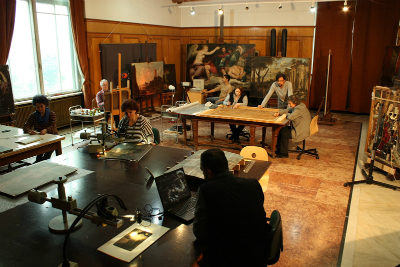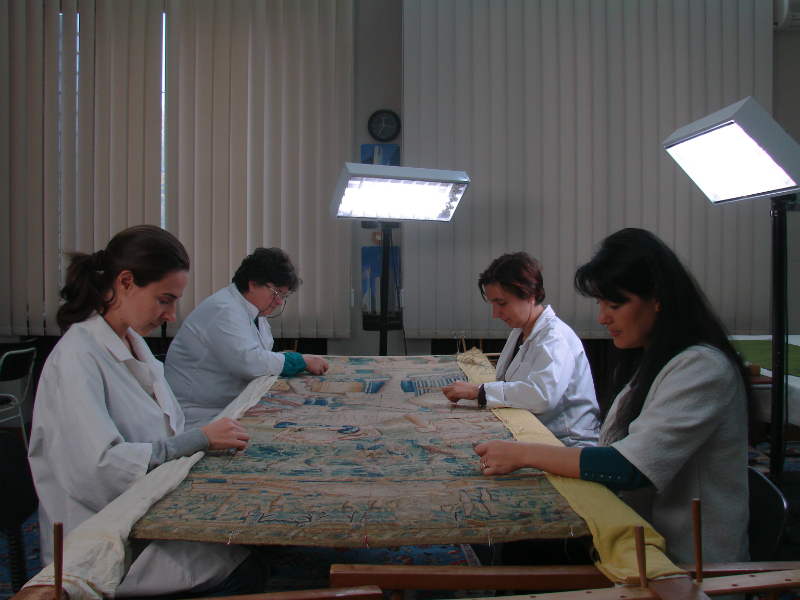A generalist conservation studio was established together with the Museum to care for all its collections. In time specialist studios emerged and developed while responsibilities became more complex, including on-site practical training to complement (post-) graduate conservation/restoration courses. In the 1970s and 1980s the Conservation Department acted as a resource and a practical learning centre, training, mapping, and sometimes covering the conservation needs of various museums in the country which had no local facilities and specialist conservators. New generations of young, mostly art graduates,were trained and continued to practice here and in other museums around the country.
Today the Conservation Department is also responsible for works in the branch museums (Art Collection Museum, K.H.Zambaccian and Theodor Pallady Museums).
December 1989 events severely damaged both collections and conservation studios. As a result during the early 1990s the studios’ refurbishment and staff training became top priorities in addressing the Museum’s conservation needs. Major international support was enlisted for equipment acquisition and professional exchanges, internships and study visits, including the conservation and restoration of several European paintings in prestigious laboratories abroad. Through this programme a generation of Museum conservators/restorers worked for various periods of time at the Stichting Restauratie Atelier Limburg (Netherlands), the Hamilton Kerr Institute, Camberwell College of Arts and the former Textile Conservation Centre at Hampton Court (UK), Bayerisches Nationalmuseum in Munich (Germany), The Getty Museum (USA), KIK-IRPA (Belgium) etc.
The Department currently comprises 8 studios (oil painting, tempera painting, graphic art, wood carving and furniture, textile, metal, ceramics and glass, frames) all specialised in art heritage. The collaborative practice developed involves conservation staff, scientists and curators and is supportive of the study, research, preservation and conservation of collections in line with present-day international standards. As a result of recent developments, areas such as stone sculpture conservation and scientific reseach are covered in partnership with specialist staff in other laboratories or outsourced.
Painting (Oil)
Established 1952

The Oil Painting Conservation studio is responsible for the Museum’s oil paintings (about 12,000 pieces), spread between the National and European Art Galleries and the branch museums. They range from fifteenth-century European panel paintings to twentieth-century Romanian painting, mediums and supports varying greatly. The studio’s chief concerns are the preservation of the material structure and of the authenticity of each individual painting, in line with contemporary conservation standards. Scientific and art historical research carried out in collaboration with scientists and curators result in an improved knowledge and understanding of paintings under scrutiny, new attributions and closer period identification.
Though totally damaged during events in December 1989, the studio soon reopened with help from European cultural institutions, its staff benefitting from a number of training stages abroad. To this day the team is involved in training younger generations of conservators and strives to upgrade the studio’s technical equipment.
By the end of 1989 no less than 3996 paintings had undergone preservation and conservation procedures in the studio. From 1990 onward staff worked on another 1400 paintings. Priority was given to works damaged during events in December 1989 and to those that went on permanent display in the Museum’s European and Romanian Art Galleries. Later the reopening of the Art Collections, Zambaccian and Pallady Museums entailed preservation and conservation procedures for all paintings on display, both Romanian and European.
During the past 25 years attention was also given to works that had not underwent major conservation since the second half of the 19th century. Thorough studies were undertaken on these ocassions, validating old attributions, making possible new ones, and leading to a more accurate dating of some of the paintings. Jacopo Bassano’s Crucifixion, Tintoretto’s Annunciation, Colijn de Coter’s panels of St Magdalene and St John, Rubens’ Portrait of Giovanna Spinola Pavese, Giorgio Vasari’s Holy Family and Lucas Cranach the Elder’s Venus and Cupid are some of the most spectacular examples.
The studio team, coordinated by Ioan Sfrijan, currently consists of Sorina Gheorghiţă, Augustina Levcenco, Crenguţa Corduban, Horaţiu Costin, Rareş Pătraşcu, Adrian Corduban (expert conservators) and Luminiţa Trucmel (assistant).
Painting (Tempera)
Established: 1952

The tempera conservation laboratory looks primarily after the Museum’s rich collection of icons, iconostases and other polychrome wood objects (roughly 2,600 pieces). Research by multidisciplinary teams including scientists, curators, art historians and conservators generated ample studies on wood painting techniques, the technology of materials, restoration and conservation methodology.
During extensive periods of training abroad conservators became familiar with various painting conservation techniques which enabled them to work on some of the Museum’s early panel paintings, some of which were damaged during events in December 1989 (Master of the Augsburg Ecce Homo, Christ Carrying the Cross). Some of these paintings were later returned to their original owner, the Brukenthal Museum in Sibiu (Hans Memling’s donor portraits, Bruegel the Elder’s Massacre of the Innocents).
Approaching paintings on a one by one basis, using modern investigation procedures, involving various colleagues at home and abroad, studio staff developed a minimal intervention strategy. About 2000 objects from both the Museum’s collection and from museums around the country underwent various procedures in the tempera conservation studio.
In time the number of experts gradually diminished (from 10 in 1990) to one (Camelia Comșia, expert restorer/conservator).
Textile
Establihed: 1960.

The studio is responsible for the Museum’s diverse textile holdings (over 2,500 pieces), ranging from Western tapestries and Romanian medieval embroideries to Oriental rugs.
Specialist staff cover many different techniques and materials, such as embroidery, lace, Western to Far Eastern fabrics and costumes, tapestry, upholstery tapestry, killim rugs and Iranian carpets. Spectacular projects carried out by various staff members during the past decades include the conservation of fragile archaeological materials as well as in-depth interdisciplinary and international research on yarn dyeing, the qualitative analysis of metal threads, etc. Projects were carried out in partnership with major national and international institutions such as KIK – IRPA Brussels, the Chemistry Department of the Bucharest University, the Romanian Textiles and Leather Research Institute, the Romanian Academy. Participation in European projects like Charisma, Spirit and Hyperion enlisted partnerships with prestigious institutions amog which the British Museum, OPD Florence, ICM Amsterdam, and Atom KIHSS Debrecen. The staff is equally involved in devising systems for the mounting, transportation and storage of textiles in the Museum’s collections.
In 2016 the studio employed 6 certified textile restorers/conservators (Luiza Gherghinescu - coordinator, Ileana Crețu, Silvia Boca, Raluca Cășaru, Iolanda Turcu, Sorina Marin) and one assistant (Mariana Bădici).
Prints and Drawings
Established: 1961

The Prints and Drawings Conservation Studio, the first of its kind in Romania, was established largley on the initiative of Ortansa Stoica, a student of graphic art at the Nicolae Grigorescu Bucharest Fine Arts Institute. Upon graduation she trained extensively first in paper restoration at the Romanian State Archives and State Library and then in Moscow, where she undertook a stage in print restoration. Upon her return she trained several generations of restorers/conservators including Yvonne Efremov, Marilena Harabagiu, Elena Ene, Lidia Zamfirescu, Nistor Coita. Through their expertise hundreds of fragile and extremely valuable works of art on paper gained a second life in the Museum and were included in various temporary exhibitions. From the 1980s onward, conservators trained in both European and Eastern mediums and materials through various stages in Japan and at Camberwell College of Arts (UK). In the past 25 years the studio staff applied their specialist knowledge to more than 4,000 works on paper displayed at the Art Collections Museum, Theodor Pallady and K.H. Zambaccian Museums as well as in many temporary exhibitions of Romanian, European and Eastern art. Though Eastern art is a major focus with the Oriental Art Gallery due to open in the near future, many works were and are included in a general prevention and active preservation programme. The staff’s expertise covers a great variety of mediums and supports, all types of paper (pulp paper, tracing paper, chemical and mechanical paste), graphic art mediums (from pencil, crayon, charcoal, watercolour, tempera) printing techniques (etching, engraving, wood-block prints), Oriental painting , documents and books.
The team currently includes expert graphic art conservators Andreia Teodorescu, Cristian Tarbă (studio coordinator), Simona Pauncev (preventive care expert, paper research and restoration, books and documents), Raluca Arnăutu (junior conservator).
Ceramic and Glass Conservation
Established: 1949

The conservation studio with overall responsibilites established in 1949 already had a certified ‘restorer’ among its staff. According to archival museum documents, Keghan Tasgian, an Armenian born in Istanbul in 1901 who practiced as a ‘certified’ ceramic restorer in his father’s antiquities shop in Bucharest in the 1920s, was among the Museum’s first employees.
The Museum’s holdings (over 8,500 items) cover a broad variety of materials from faïence, porcelain and stoneware produced by Western European, Near and Far Eastern manufactures to archaeological and ethnographic terracotta, as well as Roman and Venetian glass and Bohemia crystal. They span a period which begins in Antiquity and lasts until the twentieth century.
To decide on the correct preservation and conservation methodology conservators/restorers focus on types of materials and the technology employed as well as on types of damage. Collaboration with scientists, other conservators, curators and collection keepers is always sought as a means to reach the best possible solutions.
The studio presently employs three conservators: Cornelia Perianu (certified conservator), Vifor Pocloș (expert conservator) and Oana Solomon (expert conservator and studio coordinator).
Metal Conservation
The museum holds more than 5,500 decorative art pieces and collectibles made of gold, silver, platinum, as well as of iron, steel, cast iron, copper, bronze, brass and various zinc, lead or aluminium alloys. Many of the objects associate metal with (precious) stones, wood, ivory, bone or textiles. Age, neglect, wear and tear led to various physical as well chemical damages, often resulting in the loss of aesthetic and even functional qualities.
The metal conservation studio is actively seeking to restore the objects’s beauty through conservation procedures that would ensure them a long-lasting museum life.
As with other conservation studios, staff maintain well-documented records of the research process and conservation treatments carried out while monitoring collections and participating in professional conferences, meetings and keeping up-to-date with new materials and methodologies employed elsewhere in the world.
Staff shortages led to the temporary closure of the studio. In its present format the studio has been active since 1990, its staff comprising in 2016 two expert conservators, Aldo Chivulescu and Florin Făgărășanu.
Wood Carving and Furniture
Anul înființării: 1962

The studio was set up to address a wide range of conservation issues specific to wood, regardless of the type of work or medium to which it served as support: furniture (plain, with marquetry or inlay decoration), panels for oil and tempera painting, polychrome wood carvings. These cover the full spectrum of items in the collection, their treatment often involving collaboration with colleagues from the Museum’s other studios, with scientists and curators. Works restored feature in temporary or permanent displays in all the permanent galleries and branch museums. As time went by staff were involved in training new generations of conservators who continued to practice here and elsewhere around the country (the National Cotroceni Museum, Bucharest Municipal Museum, Târgoviște Art Museum).
In 1991 the studio’s equipment greatly improved through the generous donation made by the Bayerisches Nationalmuseum in Munich as part of the general conservation programme initiated under Director Theodor Enescu’s term in office. Up until 1989 six hundred twenty seven items had been restored in the studio. From 1990 to this day the restoration of items damaged during events in December 1989 became one of the top priorities, the studio completing work on 259 art pieces.
Presently the team includes 4 expert conservators (Mihail Tudorel Crîşmăriuc, Daniel Postelnicu, Vasile Matei) and 1 assistant (Cornelia Negoci) under the coordination of Bogdan Popescu.
Certified restorers who worked in the studio: Gheorghe Şoancă, Vlaicu Marin, Mircea Tett, Tiberiu Bentze, Nicolae Mihai, Bogdan Popescu, Costache Constantin, Florentin Tănăsescu, Daniel Oprea.


